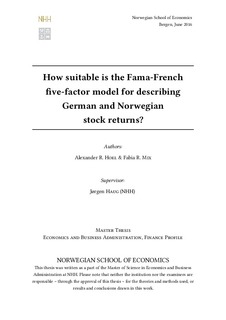How suitable is the Fama-French ve-factor model for describing German and Norwegian stock returns?
Master thesis
Permanent lenke
http://hdl.handle.net/11250/2407462Utgivelsesdato
2016Metadata
Vis full innførselSamlinger
- Master Thesis [4372]
Sammendrag
In this thesis we investigate the suitability of the Fama and French (2015a) ve-factor model
for describing German and Norwegian average monthly stock returns in the period from
1991 to 2015. We do this by estimating factor exposures and risk premiums of test portfolios
formed on three di erent double sorts on rm characteristics. Estimation is done by means of
Fama and MacBeth (1973) regressions. To secure unbiased standard errors, we apply a GMM
approach when estimating the risk premiums. We evaluate both absolute and relative model
performance on the basis of the test statistic developed by Gibbons, Ross, and Shanken (1989).
The three-factor model serves as benchmark when describing German stock returns and a
two-factor model comprising the market and the size factor is the basis for comparison in the
case of Norway.
With our thesis we make three contributions to existing literature. Firstly, we construct
the Fama-French pro tability and investment factors for the German and Norwegian stock
markets. Although the market, size and value factors are provided by others, we rebuild
them based on our model assumptions to secure internal model consistency. Secondly, by
estimating risk premiums with a GMM approach, we introduce robust standard errors to the
original estimation done by Fama and French. Thirdly, we show that the ve-factor model does
not outperform the more parsimonious benchmark models neither in describing German nor
Norwegian stock returns within our sample period and that this result is una ected by several
changes in underlying assumptions. By this, we extend others’ ndings about the German
and the Norwegian stock markets with the conclusion that the inclusion of pro tability and
investment factors, at least in our setting, does not add value to already existing models.
